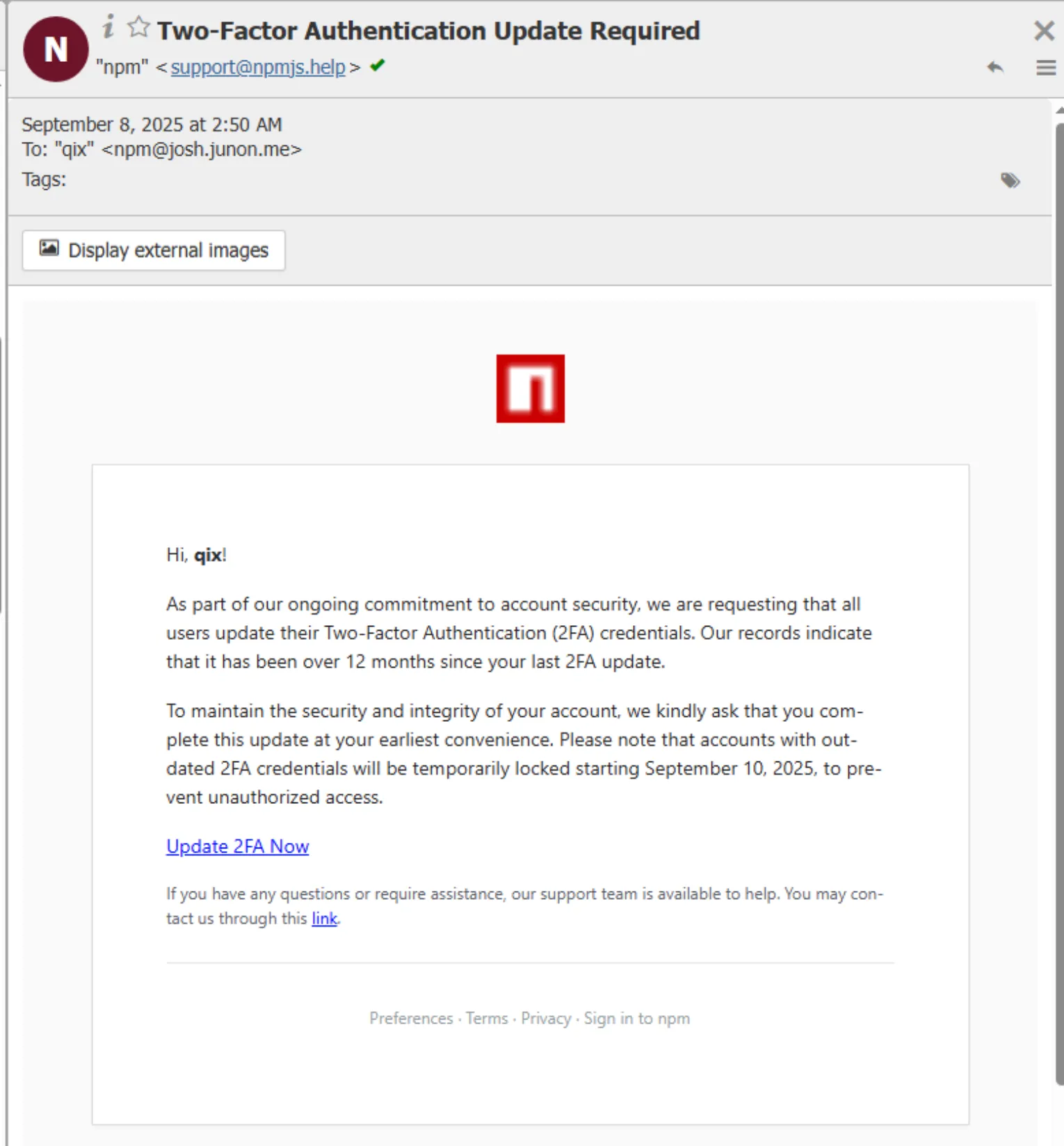
September 8, 2025: a date that will forever mark the history of cybersecurity. In the span of a few minutes, hackers orchestrated the most sophisticated attack against the JavaScript ecosystem, directly threatening the crypto wallets of millions of users worldwide. This cyberattack of unprecedented scale could have triggered the biggest crypto theft of all time.
1. The Anatomy of a Perfect Attack
The starting point: a perfectly imitated email
The attack began with a strikingly realistic phishing campaign. The cybercriminals meticulously studied official NPM (Node Package Manager) communications to create undetectable fraudulent emails.

The trap message:
- Apparent sender: support@npmjs.help (falsified domain)
- Subject: "Two-Factor Authentication Update Required"
- Content: Credible warning about a "new security policy"
- Call-to-action: "Update your 2FA before September 10 or your account will be suspended"
The perfect target: Developer "qix"
The attackers didn't choose their victim randomly. Developer "qix" maintained some of the most downloaded JavaScript packages in the world:
- chalk: 300 million weekly downloads
- strip-ansi: 261 million
- color-convert: 193 million
- color-name: 191 million
- error-ex: 47 million
These libraries are "silent dependencies," tools so fundamental that they are automatically integrated into thousands of other projects without developers noticing.
2. The Modern Trojan Horse Method
Phase 1: Account compromise
Once credentials were recovered via the phishing site, hackers took total control of "qix's" NPM account. They then had privileged access to the critical infrastructure of the modern web.
Phase 2: Discreet injection
Between 2:30 PM and 3:00 PM (French time) on September 8, the attackers published updated versions of 18 different packages. Each new version differed from the previous one by only a few lines of obfuscated code subtle enough to go unnoticed during a quick review.
Phase 3: Explosive propagation
Thanks to NPM's automatic dependency management system, these malicious versions were automatically downloaded and integrated into thousands of development projects worldwide.
3. The crypto-clipper: a weapon of mass destruction
The malware developed by the hackers represents the state of the art in cryptocurrency theft. Dubbed "crypto-clipper," it combines two complementary attack strategies of remarkable sophistication.
Strategy 1: The passive attack
This first approach exploits a human psychological weakness: our inability to distinguish very similar character strings.
The 4-step process:
- Detection: The malware continuously monitors the user's clipboard
- Analysis: When a crypto address is copied, it identifies it using regular expressions
- Calculation: It uses the Levenshtein algorithm to find the most visually similar address in its database
- Substitution: The legitimate address is replaced with the trap address
Strategy 2: The active attack
When the malware detects the presence of a connected wallet (MetaMask, WalletConnect, etc.), it switches to "predator" mode.
The interception mechanism:
- Communication hooks: The malware intercepts the wallet's
request,send, andsendAsyncfunctions - Transaction analysis: It identifies different types of crypto transactions
- In-memory modification: Parameters are modified before being displayed to the user
- Deceptive presentation: The user sees a normal transaction but actually signs a transfer to the hacker
4. Minute-by-minute attack timeline
- 2:15 PM - Phishing emails sent to 127 targeted NPM maintainers
- 2:32 PM - Developer "qix" enters credentials on fake NPM site
- 2:35 PM - First login by attackers on "qix" account
- 2:38 PM - Beginning of malicious version uploads
- 2:45 PM - Accelerated propagation: 18 compromised packages published
- 3:02 PM - First automatic download by CI/CD systems
- 3:17 PM - A British developer notices the
fetch is not definederror - 3:23 PM - In-depth investigation of the
error-ex@1.3.3package - 3:31 PM - Discovery of malicious obfuscated code
- 3:35 PM - First alert on Twitter/X by @socket_security
- 3:42 PM - NPM triggers emergency procedure
- 3:58 PM - Removal of malicious versions from NPM index
- 4:15 PM - Publication of official NPM alert
5. The bone-chilling numbers
The scale of the threat
- 18 NPM packages compromised simultaneously
- Over 2 billion weekly downloads affected
- 127 maintainers targeted by phishing emails
- 1 single developer ultimately compromised
- 23 minutes between first malicious publication and detection
- 583 projects downloaded compromised versions before removal
The prepared crypto arsenal
The hackers had prepared a veritable arsenal of crypto addresses to maximize their gains: 80 Bitcoin addresses, 59 Ethereum addresses, 20 Solana addresses, 40 Tron addresses, 40 Litecoin addresses, as well as 40 Bitcoin Cash addresses.
The paradox of limited success
Despite the potential scale:
- Approximately $1,000 actually stolen
- 3 malicious transactions confirmed on the blockchain
- 0 major projects definitively compromised
Crypto beyond code: toward global security
This NPM attack reminds us of a fundamental truth: in the crypto ecosystem, threats can come from anywhere. Today, it was a flaw in the JavaScript infrastructure. Tomorrow, it could be a trapped smart contract, malicious tokenomics, or a phantom development team.
Why auditing becomes critical
Faced with this escalation, manual analysis becomes insufficient. An average investor cannot:
- Audit thousands of lines of Solidity code
- Verify the legitimacy of a development team
- Analyze token distribution in real-time
- Monitor liquidity movements 24/7
Artificial intelligence in service of crypto security
This is exactly where tools like Kryll X-Ray transform the game. Where the NPM attack targeted development infrastructure, the majority of crypto traps hide within the projects themselves.
From Reaction to Prevention
The NPM attack showed us the importance of rapid detection. In the crypto world, speed can make the difference between a healthy investment and a total loss.
While developers took 23 minutes to detect the NPM malware, X-Ray analyzes a crypto project in less than 30 seconds to reveal its vulnerability points.
Why use X-Ray?
DYOR is good. DYOR with X-Ray is better. Here's why this tool will drastically change your approach to the crypto market:
⚡ Instant complete audit: Get a clear overview of a token in seconds: smart contract, on-chain data, financial metrics, and social signals all in one place.
🔐 Enhanced risk detection: X-Ray immediately spots warning signals: trapped contracts, unlimited mint, concentrated holders, or security flaws on the project's website.
🧭 Considerable time savings: No more endless hours of research: X-Ray centralizes all critical data in one click.
🗣️ Accessible to everyone: The intuitive interface, clear visuals, and simplified explanations make the audit understandable regardless of your level.
💬 AI integration: Ask a question to the Kryll³ AI Agent to trigger an audit or deepen a point, without even opening the interface. 100% conversational, as if you were talking to a crypto expert with infinite knowledge.
📚 Continuous learning: Explore data and develop your crypto skills with each use. Every audit is a lesson.
With all these cross-analyses, X-Ray offers much more than a simple glance: it's a true intelligent dashboard, designed so everyone can understand, compare, and decide without getting lost in complexity.
| Criteria | Manual Audit 😩 | Audit with X-Ray 😎 |
|---|---|---|
| Ease | Complex | ✅ Ultra-simple |
| Time spent | Several hours | ✅ A few minutes |
| Risks detected | Variable | ✅ Automatically listed |
| Number of tools needed | Several dozens | ✅ All-in-one in X-Ray |
| AI Agent integration | None | ✅ Integrated |
How to access X-Ray?
Want to audit a token or do a quick check before investing? The X-Ray module from Kryll³ is here to simplify your life. Here's how to access it in seconds:
- Go to the X-Ray tab on the Kryll³ platform
- Connect your Web3 wallet to unlock all X-Ray features (Don't have a Web3 wallet? Click here)
✅ You're now on X-Ray!
All you have to do is enter the name or address of a token to launch the complete analysis and get a clear and synthetic audit of the crypto of your choice.


